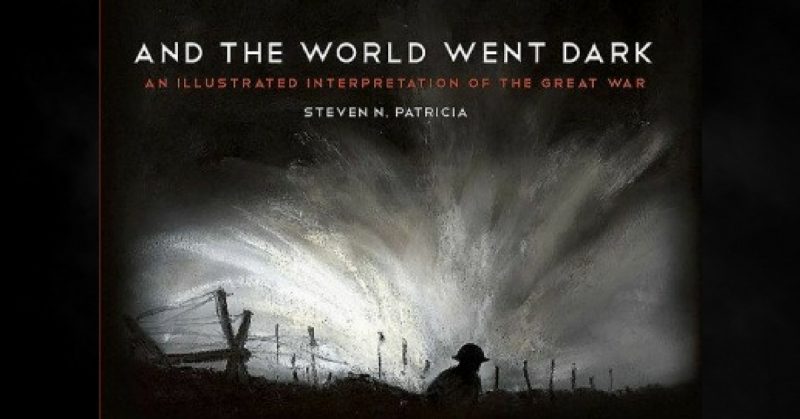The waves of Centennial market-chasing Great War books are lapping over my Hush Puppies and, believe me, we are nowhere near high tide. A hundred years on from all the futility – yadda, yadda, yadda; things are getting quite colorful. I read a story that a ballet company is going to interpret the war through dance. I really cannot see some petite lass standing tippy-toe in a pair of ammunition boots and those serge trousers have gotta chafe. But fair play to them.
So let’s crack on with this interesting book by the Pennsylvania-based artist Steven N Patricia. In it he looks at many facets of the war with snippets of statistics, stories and memories accompanying an extensive collection of his original artwork. He uses a range of media to get the results he is looking for. While the majority seem to be beautifully executed pencil drawings, others appear to be pastel and brushwork. There are some genuinely lovely pieces in the book and I especially like the image of bombers at night and the tanks crashing over wire look awesome. Some of the images of people, all sunken-eyed and not a little ghostly are quite chilling.
I looked up the author’s website to check out how serious he is about all this stuff and am pleased to see he has spent his career working as an illustrator for historical and architectural projects. His interpretations of long lost communities and buildings are first rate. I am happy to see he is not just another chancer on the WW1 gravy train. This is a serious piece of work done with care and love.
Mr. Patricia does some of his work from original photographs, and it is fun pointing them out – well, I think so – but he has also done a lot of research for the more original stuff. His illustrating style reminds me a lot of the work of Raymond Briggs, but there are no snowmen here. The book has an originality I find refreshing, and it has served as a nice reboot for my brain after an intense period of work. Being an American the author isn’t obsessed with the British at Flanders and the Somme and all the stuff I alluded to at the start and in previous reviews. He confirms the conflict was a world war and is inclusive in his choice of subject matter. This is all to the good.
Yes, this is an interpretation. It says so on the cover. These things can be hit or miss, and it is true that beauty is in the eye of the beholder. Whether an unusual book like this will appeal to mainstream Great War buffs like my fellow inmates at the Southend-on-Sea branch of the Western Front Association is a moot point. But I see no reason why it shouldn’t appeal to students of war art; or any high-quality art for that matter. I really enjoyed it and liked the concept on every level.
Books like this make us think about the war in deeper terms than mere flags, nationality or kit and caboodle. This book is about people and the human experience. It is not superficial. It all serves to add depth to our collective remembrance, and this is no bad thing. I personally think this is one you would need to skim through in a bookstore rather than buy off the t’interweb, but that is how I roll. This project isn’t an exercise in Centennial futility, and I am happy to give it the thumbs up.
Reviewed by Mark Barnes for War History Online.

AND THE WORLD WENT DARK
An Illustrated Interpretation of the Great War
By Steven N Patricia
Casemate Publishers
ISBN: 978 1 61200 348 1
